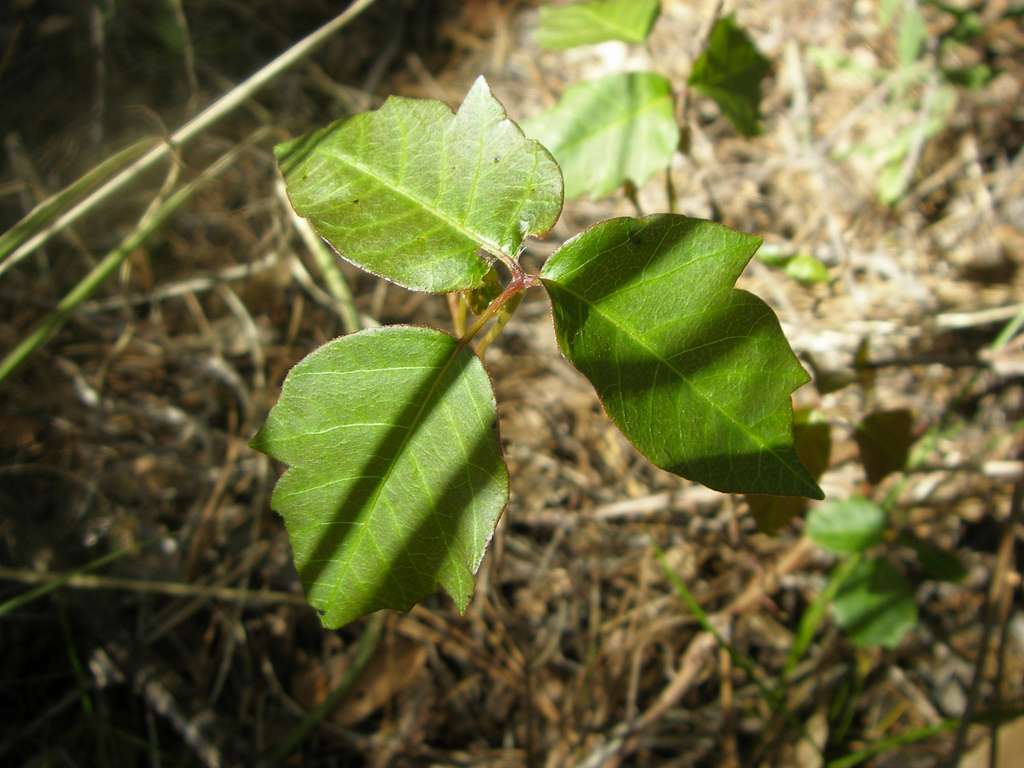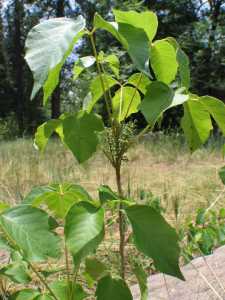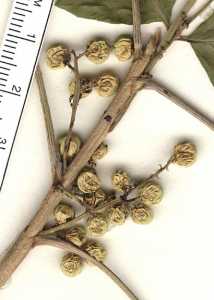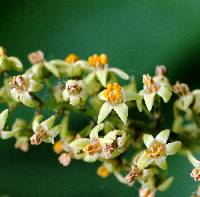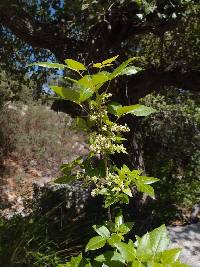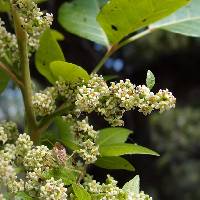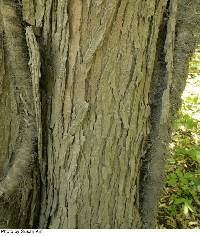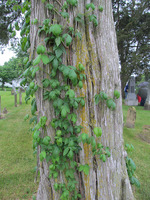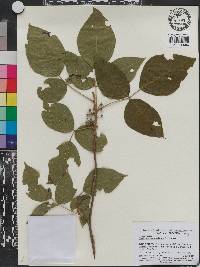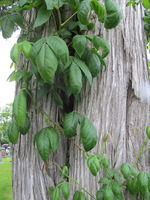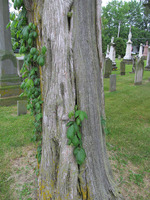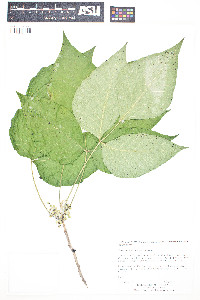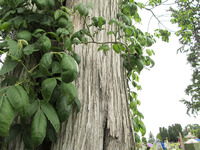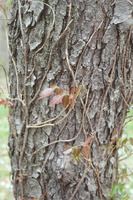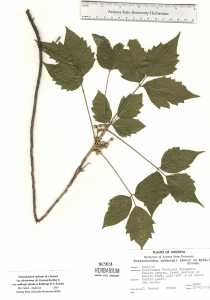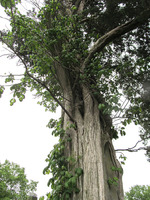- Home
- Search
- Images
- Datasets
- Sample Use
- How to Cite
- Additional Information
- About NEON
- NEON Data Portal
- ASU Biocollections
- About Symbiota
|
|
|
|
Family: Anacardiaceae
eastern poison ivy
|
PLANT: Vines climbing with aerial roots to 30 m or sparsely branched rhizomatous shrubs, to 1.5 m tall; branches puberulent to glabrous. LEAVES: trifoliolate (rarely 5 foliolate); petioles puberulent to glabrous, 2-17 cm long; terminal leaflets with a petiolule to 3 cm long; lateral leaflets subsessile; leaflets narrowly to broadly ovate, 2-7 cm wide, 3-13 cm long entire or notched to crenate or serrate; bases rounded; apices acuminate. INFLORESCENCE: a short, narrow panicle to 5 cm long, bracts lanceolate, deciduous. FLOWERS: to 3 mm long; sepals deltoid, greenish, glabrate; petals oblanceolate, cream to yellowish with dark veins. FRUIT globose, to 5 mm in diameter, cream, striate, glabrous. NOTES: 10 vars., 2 in AZ their ranges meeting in se AZ where intermediates occur. REFERENCES: John L. Anderson, 2006, Vascular Plants of Arizona: Anacardiaceae. CANOTIA 3 (2): 13-22. Woody vine or shrub 1.2 m long (vine) or 45 cm tall (shrub). Leaves: alternate, stalked, with three leaflets (trifoliate). Flowers: either male or female, growing on separate plants (dioecious), borne on a loosely branched inflorescence (panicle), usually with more than 25 flowers per inflorescence. The five petals are cream-colored to yellowish green, 2 - 5 mm long, and larger in male flowers. Flowers may develop even in very young plants. Fruit: fleshy with a center seed (drupe), borne on stalked clusters often hanging downward, each drupe 3 - 5 mm across. Seeds are round, white to cream, sometimes with gray stripes. Leaflets: stalked (middle leaflet stalk longest), reddish purple when young, becoming glossy green, 3 - 15 cm long, egg-shaped to elliptic with a pointed tip, non-toothed or with few irregular teeth or shallow lobes. Form: climbing or trailing, rarely suberect, often with aerial roots, spreading by rhizomes to form colonies. Similar species: Toxicodendron radicans is thought to be represented by the subspecies negundo in the Chicago Region due to its hairless fruit. See link below for further information. Toxicodendron rydbergii is a shrub or subshrub that lacks aerial roots but has very broad to nearly circular leaflets and a more compact and erect fruit cluster. A few tree and shrub species may be mistaken for T. radicans, especially as seedlings. Acer negundo and Staphylea trifolia have opposite leaf arrangements. Ptelea trifoliata ssp. trifoliatahas an alternate leaf arrangement, but the leaflets are all very short-stalked with non-toothed to finely toothed margins. Flowering: late May to late June Habitat and ecology: Very common in many habitats including woodlands, wooded floodplains, sandy black oak savannas, dune slopes facing Lake Michigan, and fields. Occurence in the Chicago region: native Notes: Avoid touching this plant, as it contains a toxic compound called urushiol. Do not burn it, as the toxin is released into the air and can be inhaled. After contact with urushiol, a person sesitive to the toxin becomes itchy, and within 24 - 48 hours the skin blisters and reddens. If tools or clothing have been contaminated, they should be washed with hot water and soap. Etymology: Toxicodendron means "poison tree." Radicans means "having rooting stems." Author: The Morton Arboretum Climbing or straggling vine, producing abundant aerial roots; lfls 3, mostly flat, 5-15 cm, ovate to elliptic, acute or acuminate, entire or often with a few irregular, ±pointed teeth or shallow lobes; terminal lfl long-petiolulate, the others subsessile or short-petiolulate; infls to 1 dm, loose, branched, with mostly more than 25 fls, often ±pendulous in fr; frs pedicellate, mostly 3-5 mm thick; 2n=30. Commonly in open woods, often in disturbed habitats, sometimes in more open sites with nothing to climb on; s. N.S. to Fla., w. to Mich., se. Minn., e. Neb., Okla., and Tex. and s. to Guat.; also in China and Japan. May-July. (Rhus r.) Several confluent vars., 2 in our range. Gleason, Henry A. & Cronquist, Arthur J. 1991. Manual of vascular plants of northeastern United States and adjacent Canada. lxxv + 910 pp. ©The New York Botanical Garden. All rights reserved. Used by permission. Anderson 2007 Common Name: eastern poison ivy Duration: Perennial Nativity: Native Lifeform: Shrub Wetland Status: FAC General: Woody vines to 30 m, climbing with aerial roots, or sparsely branched rhizomatous shrubs, to 1.5 m tall; branches puberulent to glabrous. Leaves: Winter-deciduous, alternate, petioled, trifoliolate (rarely 5 foliolate); petioles puberulent to glabrous, 2-17 cm long; terminal leaflets with a petiolule to 3 cm long; lateral leaflets subsessile; leaflets narrowly to broadly ovate, 2-7 cm wide, 3-13 cm long, entire or notched to crenate or serrate; bases rounded; apices acuminate. Flowers: Cream-colored, in short, narrow panicles to 5 cm long; bracts lanceolate, deciduous; flowers to 3 mm long; sepals deltoid, greenish, glabrate; petals 5, oblanceolate, cream to yellowish with dark veins. Fruits: Cream-colored drupes (single seeded fleshy fruits) to 5 mm in diameter, globose, striate, glabrous. Ecology: Found in moist but often sunny sites in canyon bottoms and at seeps and springs, below 8,500 ft (2591 m); flowers April-June. Distribution: Native to N. Amer., C. Amer., the Carribean, and e Asia; In N. Amer, found throughout the US, s CAN, and MEX. Ethnobotany: Used for basketmaking, as a dye for textiles, and curiously, a variety of culinary and medicinal uses have been reported. Synonyms: Rhus radicans Editor: AHazelton 2015 Etymology: Derived from the latin toxicum, -poison" and the Greek dendron, -tree;" radicans is from the Latin for -root," and refers to the stems producing aerial roots. |
|
|
|


